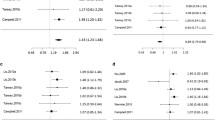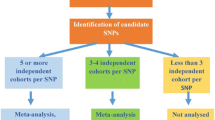Abstract
Autism spectrum disorders (ASDs) are heterogeneous disorders presenting with increased rates of anxiety. The adenosine A2A receptor gene (ADORA2A) is associated with panic disorder and is located on chromosome 22q11.23. Its gene product, the adenosine A2A receptor, is strongly expressed in the caudate nucleus, which also is involved in ASD. As autistic symptoms are increased in individuals with 22q11.2 deletion syndrome, and large 22q11.2 deletions and duplications have been observed in ASD individuals, in this study, 98 individuals with ASD and 234 control individuals were genotyped for eight single-nucleotide polymorphisms in ADORA2A. Nominal association with the disorder was observed for rs2236624-CC, and phenotypic variability in ASD symptoms was influenced by rs3761422, rs5751876 and rs35320474. In addition, association of ADORA2A variants with anxiety was replicated for individuals with ASD. Findings point toward a possible mediating role of ADORA2A variants on phenotypic expression in ASD that need to be replicated in a larger sample.

Similar content being viewed by others
References
Alsene K, Deckert J, Sand P, de Wit H (2003) Association between A2a receptor gene polymorphisms and caffeine-induced anxiety. Neuropsychopharmacology 28:1694–1702
American Psychiatric Association (1994) Diagnostic and statistical manual of mental disorders (DSM-IV), 4th edn. American Psychiatric Association, Washington, DC
Baird G, Simonoff E, Pickles A, Chandler S, Loucas T, Meldrum D, Charman T (2006) Prevalence of disorders of the autism spectrum in a population cohort of children in South Thames: the special needs and autism project (SNAP). Lancet 368:210–215
Bolte S, Poustka F (2004) The German form of the autism diagnostic observation schedule (ADOS): first results on reliability and validity. Zeitschrift fur Kinder-und Jugendpsychiatrie und Psychotherapie 32:45–50
Chen JF, Moratalla R, Impagnatiello F, Grandy DK, Cuellar B, Rubinstein M, Beilstein MA, Hackett E, Fink JS, Low MJ, Ongini E, Schwarzschild MA (2001) The role of the D(2) dopamine receptor (D(2)R) in A(2A) adenosine receptor (A(2A)R)-mediated behavioral and cellular responses as revealed by A(2A) and D(2) receptor knockout mice. Proc Natl Acad Sci USA 98:1970–1975
Childs E, Hohoff C, Deckert J, Xu K, Badner J, de Wit H (2008) Association between ADORA2A and DRD2 polymorphisms and caffeine-induced anxiety. Neuropsychopharmacology 33:2791–2800
Deckert J, Nothen MM, Franke P, Delmo C, Fritze J, Knapp M, Maier W, Beckmann H, Propping P (1998) Systematic mutation screening and association study of the A1 and A2a adenosine receptor genes in panic disorder suggest a contribution of the A2a gene to the development of disease. Mol Psychiatry 3:81–85
Freitag CM (2007) The genetics of autistic disorders and its clinical relevance: a review of the literature. Mol Psychiatry 12:2–22
Hamilton SP, Slager SL, De Leon AB, Heiman GA, Klein DF, Hodge SE, Weissman MM, Fyer AJ, Knowles JA (2004) Evidence for genetic linkage between a polymorphism in the adenosine 2A receptor and panic disorder. Neuropsychopharmacology 29:558–565
Hohoff C, Marziniak M, Lesch KP, Deckert J, Sommer C, Mossner R (2007) An adenosine A2A receptor gene haplotype is associated with migraine with aura. Cephalalgia 27:177–181
Hohoff C, McDonald JM, Baune BT, Cook EH, Deckert J, de Wit H (2005) Interindividual variation in anxiety response to amphetamine: possible role for adenosine A2A receptor gene variants. Am J Med Genet B Neuropsychiatr Genet 139:42–44
Koles L, Wirkner K, Illes P (2001) Modulation of ionotropic glutamate receptor channels. Neurochem Res 26:925–932
Leyfer OT, Folstein SE, Bacalman S, Davis NO, Dinh E, Morgan J, Tager-Flusberg H, Lainhart JE (2006) Comorbid psychiatric disorders in children with autism: interview development and rates of disorders. J Autism Dev Disord 36:849–861
Lord C, Risi S, Lambrecht L, Cook E H Jr, Leventhal BL, DiLavore PC, Pickles A, Rutter M (2000) The autism diagnostic observation schedule-generic: a standard measure of social and communication deficits associated with the spectrum of autism. J Autism Dev Disord 30:205–223
Lord C, Rutter M, Le Couteur A (1994) Autism diagnostic interview-revised: a revised version of a diagnostic interview for caregivers of individuals with possible pervasive developmental disorders. J Autism Dev Disord 24:659–685
Marshall CR, Noor A, Vincent JB, Lionel AC, Feuk L, Skaug J, Shago M, Moessner R, Pinto D, Ren Y, Thiruvahindrapduram B, Fiebig A, Schreiber S, Friedman J, Ketelaars CE, Vos YJ, Ficicioglu C, Kirkpatrick S, Nicolson R, Sloman L, Summers A, Gibbons CA, Teebi A, Chitayat D, Weksberg R, Thompson A, Vardy C, Crosbie V, Luscombe S, Baatjes R, Zwaigenbaum L, Roberts W, Fernandez B, Szatmari P, Scherer SW (2008) Structural variation of chromosomes in autism spectrum disorder. Am J Hum Genet 82:477–488
Melchers, P., Preuß, U. (2001) Kaufman assessment battery for children, German version, 6th edn. Hogrefe, Göttingen
Moreau JL, Huber G (1999) Central adenosine A(2A) receptors: an overview. Brain Res Brain Res Rev 31:65–82
Pardo CA, Eberhart CG (2007) The neurobiology of autism. Brain Pathol 17:434–447
Poustka F, Lisch S, Ruhl D, Sacher A, Schmotzer G, Werner K (1996) The standardized diagnosis of autism, autism diagnostic interview-revised: interrater reliability of the German form of the interview. Psychopathology 29:145–153
Retey JV, Adam M, Honegger E, Khatami R, Luhmann UF, Jung HH, Berger W, Landolt HP (2005) A functional genetic variation of adenosine deaminase affects the duration and intensity of deep sleep in humans. Proc Natl Acad Sci USA 102:15676–15681
Schiffmann SN, Fisone G, Moresco R, Cunha RA, Ferre S (2007) Adenosine A(2A) receptors and basal ganglia physiology. Prog Neurobiol 83:277–292
Schneider T, Ziolkowska B, Gieryk A, Tyminska A, Przewlocki R (2007) Prenatal exposure to valproic acid disturbs the enkephalinergic system functioning, basal hedonic tone, and emotional responses in an animal model of autism. Psychopharmacology (Berl) 193:547–555
Sebat J, Lakshmi B, Malhotra D, Troge J, Lese-Martin C, Walsh T, Yamrom B, Yoon S, Krasnitz A, Kendall J, Leotta A, Pai D, Zhang R, Lee YH, Hicks J, Spence SJ, Lee AT, Puura K, Lehtimaki T, Ledbetter D, Gregersen PK, Bregman J, Sutcliffe JS, Jobanputra V, Chung W, Warburton D, King MC, Skuse D, Geschwind DH, Gilliam TC, Ye K, Wigler M (2007) Strong association of de novo copy number mutations with autism. Science 316:445–449
Stanfield AC, McIntosh AM, Spencer MD, Philip R, Gaur S, Lawrie SM (2008) Towards a neuroanatomy of autism: a systematic review and meta-analysis of structural magnetic resonance imaging studies. Eur Psychiatry 23:289–299
Stephens M, Donnelly P (2003) A comparison of bayesian methods for haplotype reconstruction from population genotype data. Am J Hum Genet 73:1162–1169
Tellegen PJ, Winkel M, Laros JA (1998) SON-R 2 1/2-7. Non-verbaler Intelligenztest
Tewes U, Neubauer A, von Aster M (2006) WIE. Wechsler Intelligenztest für Erwachsene
Tewes U, Rossmann P, Schallberger U (2000) HAWIK-III. Hamburg-Wechsler-Intelligenztest für Kinder III
Vorstman JA, Morcus ME, van Engeland H (2007) Autism in children with 22q11.2 deletion syndrome. J Am Acad Child Adolesc Psychiatry 46:434–435
Yu L, Frith MC, Suzuki Y, Peterfreund RA, Gearan T, Sugano S, Schwarzschild MA, Weng Z, Fink JS, Chen JF (2004) Characterization of genomic organization of the adenosine A2A receptor gene by molecular and bioinformatics analyses. Brain Res 1000:156–173
Acknowledgments
We thank the participating individuals for taking part in the study. The study was supported by grant T6 03 10 00-45 of the Saarland University to Christine M. Freitag.
Conflict of interest statement
None of the authors has any conflicts of interest.
Author information
Authors and Affiliations
Corresponding author
Rights and permissions
About this article
Cite this article
Freitag, C.M., Agelopoulos, K., Huy, E. et al. Adenosine A2A receptor gene (ADORA2A) variants may increase autistic symptoms and anxiety in autism spectrum disorder. Eur Child Adolesc Psychiatry 19, 67–74 (2010). https://doi.org/10.1007/s00787-009-0043-6
Received:
Accepted:
Published:
Issue Date:
DOI: https://doi.org/10.1007/s00787-009-0043-6




